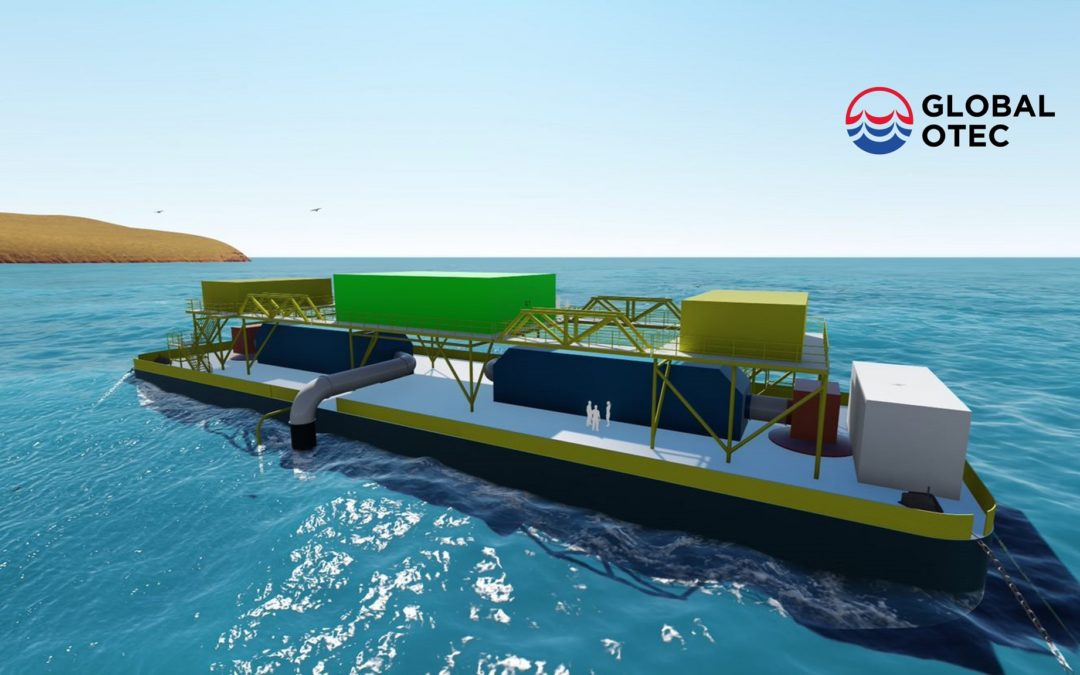News

No More! Leaders from small islands abandoning fossil fuels for ocean energy – Global Ocean Energy Alliance (GOEA) formed with international partners
“This may very well be our last chance. Some may accuse us of being overly dramatic, but we can assure you, there is no drama when as the leaders of small islands and coastal cities, year after year, you bury the dead from climate-induced natural disasters, including young children, who are the most vulnerable and so small they cannot help themselves. You scramble to provide security and shelter for your people, freshwater, and enough energy to keep the lights on in your hospitals to tend to those injured. No more!”

Global OTEC UK has been given the green light from leaders of small islands and coastal cities for its Floating OTEC Platform
The leaders of Small Island Developing States (SIDS) and coastal cities announced it approves the development and deployment of the first Floating OTEC Platform using the dominant form of energy generation around the world today, by the United Kingdom (UK) company, Global OTEC.

Grenada’s Prime Minister Receives Excellency In Leadership Award
PHOTO RELEASE FOR IMMEDIATE RELEASE Grenada’s Prime Minister Receives Excellency In Leadership Award 1st October 2021 – Grenada’s Prime Minister, Dr. the Right Honourable Keith Mitchell is the 2020-2021 recipient of the Excellency in Leadership Award, presented by the...

95% of existing ocean climates could disappear by 2100 if CO2 emissions continue to climb
Canada is home to three oceans, all of which harbour thousands of fish and animals, on which many Canadians rely. But, with a warming planet, these bodies of water are rapidly changing.
A new study published in the journal Scientific Reports suggests that our oceans’ climates — existing environments with delicately balanced ecosystems — face extreme change under climate-change scenarios.

Climate change fueling warm ocean ‘blob’ causing Chile megadrought – study
By Cassandra Garrison
(Reuters) – A blob of warm water in the southern Pacific is fueling a decade-long megadrought in Chile, and climate change is at least partly to blame, scientists say.
The “Southern Blob” east of New Zealand is driving hot and dry conditions in Chile, with snow caps melting https://www.reuters.com/world/europe/mega-drought-andes-leaves-some-peaks-without-snow
Novel and disappearing climates in the global surface ocean from 1800 to 2100
Abstract
Marine ecosystems are experiencing unprecedented warming and acidification caused by anthropogenic carbon dioxide. For the global sea surface, we quantified the degree that present climates are disappearing and novel climates (without recent analogs) are emerging, spanning from 1800 through different emission scenarios to 2100. We quantified the sea surface environment based on model estimates of carbonate chemistry and temperature. Between 1800 and 2000, no gridpoints on the ocean surface were estimated to have experienced an extreme degree of global disappearance or novelty. In other words, the majority of environmental shifts since 1800 were not novel,

SIDS DOCK and Global OTEC Resources announce partnership to develop and deploy Floating Ocean Thermal Energy Conversion (OTEC) Technology Concept in small islands
07 July 2021, United Nations Headquarters, New York, U.S.A.: SIDS DOCK, the Small Island Developing States (SIDS) Sustainable Energy and Climate Resilience Organization, has signed an agreement with the United Kingdom (UK)-based Global OTEC Resources Limited, to collaborate on developing and deploying Floating Ocean Thermal Energy Conversion (OTEC) Technology Concept in SIDS. The signing ceremony took place on Friday, 2 July 2021, by means of a virtual conference between representatives in Seychelles, Jamaica, Portugal and the United Kingdom.

Carbon Dioxide, Which Drives Climate Change, Reaches Highest Level In 4 Million Years
This 2019 photo provided by NOAA shows the Mauna Loa Atmospheric Baseline Observatory in Hawaii. Measurements taken at the station in May 2021 revealed the highest monthly average of atmospheric carbon dioxide in human history.
Susan Cobb/NOAA Global Monitoring Laboratory
The amount of carbon dioxide in Earth’s atmosphere reached 419 parts per million in May, its highest level in more than four million years, the National Oceanic and Atmospheric Administration announced on Monday.
